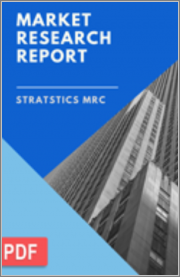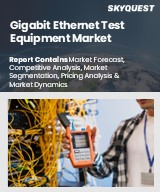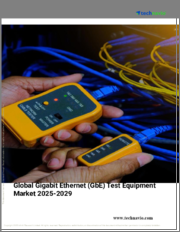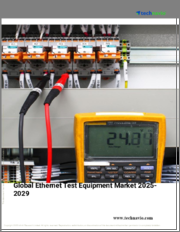
|
시장보고서
상품코드
1383357
신속 BOD 측정법 장비 시장 예측(-2030년) : 유형, 유통 채널, 기술, 용도, 지역별 세계 분석BOD Quick Test Method Equipment Market Forecasts to 2030 - Global Analysis By Type, Distribution Channel, Technology, Application and By Geography. |
||||||
Stratistics MRC에 따르면 세계 신속 BOD 측정법 장비 시장은 2023년 8,166만 달러로 예측 기간 동안 CAGR 4.7%로 성장하여 2030년에는 1억 1,263만 달러에 달할 것으로 예상됩니다.
신속한 생화학적 산소요구량(BOD) 측정법 장비는 물 샘플의 BOD를 신속하게 측정하는 데 사용되는 장비 및 도구 세트입니다. 수질 및 환경 위생의 신속한 평가에 필수적입니다. 유기 오염 수준을 신속하게 모니터링하고, 적시에 개입 및 보존 활동을 촉진하고, 담수 생태계의 지속가능성을 보장하고, 공중 보건을 보호할 수 있습니다.
수질 모니터링에 대한 수요
수질 오염에 대한 우려가 커지면서 수질을 적시에 정확하게 평가해야 할 필요성이 그 어느 때보다 높아지고 있습니다. 농업, 양식업, 지자체 수처리 시설, 산업 공정 등 다양한 분야에서 생태계와 공중 보건의 안전을 보장하기 위해 효과적인 수질 모니터링에 의존하고 있으며, BOD(생화학적 산소요구량) 신속 측정 장비는 수역의 유기물 오염 수준을 신속하게 평가하여 이 점에서 매우 중요한 역할을 합니다. 중요한 역할을 하고 있습니다. 이 실시간 데이터는 의사 결정권자에게 신속한 시정 조치를 취할 수있는 권한을 부여하여 환경 파괴를 완화하고 수자원의 지속가능한 사용을 보장합니다. 그 결과, BOD 신속 측정 장비에 대한 수요는 전 세계 수질 관리 노력에 필수적인 도구로 계속 증가하고 있습니다.
높은 비용
신속 BOD 측정법 장비의 높은 비용은 시장의 주요 억제요인입니다. 이러한 검사 장비는 신속한 수질 평가에 유용하지만 구입, 유지 및 운영 비용이 많이 듭니다. 이 비용 요소는 특히 소규모 지자체, 자원이 부족한 조직 및 예산이 제한된 지역에서는 장벽이 될 수 있습니다. 초기 투자 및 교정, 유지보수, 소모품에 대한 지속적인 비용은 재정을 압박할 수 있습니다. 그 결과, 많은 잠재적 사용자가 BOD 신속 측정법의 장점에도 불구하고 채택을 주저할 수 있으며, 이는 보급을 제한할 수 있습니다.
급속한 산업화
유기오염물질을 함유한 폐수를 다량으로 생산하는 기업이 증가하고 있으며, BOD 테스트는 이러한 산업 폐수를 관리하고 통제하기 위해 점점 더 엄격해지는 환경 규제를 준수하기 위해 필요하며, BOD 신속 검사 장비는 폐수를 관리 및 모니터링하고 규정을 준수하는 효율적인 방법을 제공합니다. 을 제공합니다. 이 기술을 통해 산업 시설은 폐수 품질을 신속하게 평가하고 처리 절차를 실시간으로 수정하여 운영으로 인한 환경 영향을 줄일 수 있습니다.
전문기술과 훈련의 필요성
신속 BOD 측정법 장비의 작동에는 전문적인 기술과 훈련이 필요하기 때문에 시장에 위협이 될 수 있습니다. 사용자는 종종 장비, 테스트 프로토콜 및 데이터 해석에 대한 깊은 이해가 필요하며, 이는 보급의 장벽이 될 수 있습니다. 숙련된 인력이 필요하기 때문에 운영 비용이 증가하여 리소스가 제한된 조직에서는 사용이 제한될 수 있습니다. 또한, 장비가 제대로 작동되지 않으면 오류나 부정확성을 초래할 수 있습니다.
COVID-19의 영향
팬데믹 기간 동안 급속 BOD 측정법 장비 시장은 긍정적인 영향과 부정적인 영향을 모두 경험했습니다. 한편으로는 공중 보건과 안전에 대한 관심이 높아지면서 수질과 정확한 검사 방법의 필요성에 대한 인식이 높아졌습니다. 그 결과 정부, 규제 기관 및 수처리 시설이 식수 공급의 안전성을 보장하기 위해 노력하면서 BOD 시험 장비에 대한 수요가 급증했습니다. 또한 많은 환경 연구소가 예산 제약과 인력 감축에 직면하여 구매 결정과 프로젝트 실행 속도가 느려지고 있습니다. 수질에 대한 관심이 높아지면서 수요를 견인하는 반면, 전염병으로 인한 혼란은 시장 성장의 장애물이 되고 있습니다.
예측 기간 동안 휴대용 신속 BOD 측정법 장비 부문이 가장 큰 비중을 차지할 것으로 예상
휴대용 신속 BOD 측정법 장비 부문이 가장 큰 점유율을 차지할 것으로 추정됩니다. 휴대용 신속 BOD 측정법 장비는 물 샘플의 현장 또는 현장 테스트를 위해 설계된 작고 가볍고 쉽게 휴대할 수 있는 기기를 말합니다. 이 장비는 실험실 설치가 필요하지 않고 실시간 BOD 측정의 편리함을 제공합니다. 휴대용 BOD 장비는 환경 모니터링 기관, 규제 기관 및 분산 운영되는 산업에 특히 유용합니다. 또한, 원격지, 산업 현장 및 비상시 수질 평가를 신속하게 수행할 수 있기 때문에 기존의 실험실 기반 검사가 실용적이지 않은 생태계를 준수하고 오염을 관리하며 생태계를 보호하는 데 필수적인 도구가 되고 있습니다.
예측기간 동안 가장 높은 CAGR을 기록할 것으로 예상되는 분야는 상하수도 처리 분야
상하수도 처리 분야는 예측 기간 동안 유리한 성장세를 보일 것으로 예상됩니다. 수처리 및 폐수 처리는 지자체 수처리 플랜트, 산업 시설, 물과 폐수 관리를 담당하는 환경 기관의 요구에 맞는 BOD 검사 장비의 전문 카테고리입니다. 이 장비는 유입되는 수원과 처리된 폐수의 유기물 오염 수준을 신속하고 정확하게 평가할 수 있도록 설계되었습니다. 이 분야는 처리 공정의 효율성, 환경 규제 준수 및 공중 보건 보호를 보장하는 데 중요한 역할을 합니다. 또한 신속하고 정확한 BOD 측정을 용이하게함으로써 수처리 및 폐수 처리 작업의 효율성과 지속가능성을 높입니다.
가장 큰 점유율을 차지하는 지역
추정 기간 동안 아시아태평양이 가장 큰 시장 점유율을 차지했습니다. 아시아태평양은 신속 BOD 측정법 장비의 중요하고 역동적인 시장입니다. 급속한 산업화, 인구 증가, 환경 문제에 대한 관심 증가로 인해 효율적인 수질 모니터링 도구에 대한 수요가 증가하고 있습니다. 이 지역의 많은 국가에서 환경 규제가 강화됨에 따라 산업계와 지자체는 규정 준수와 오염 방지를 위해 BOD 테스트 장비를 채택하고 있습니다. 또한, 아시아태평양은 특히 물 스트레스가 높은 인구 밀집 지역에서 지속가능한 물 관리 관행에 대한 필요성이 증가함에 따라 성장 잠재력을 가지고 있습니다. 이 지역은 BOD 장비에 대한 혁신과 투자를 목격하고 있으며, 시장 개척을 위한 중요한 거점이 되고 있습니다.
CAGR이 가장 높은 지역:
북미 지역은 예측 기간 동안 수익성 높은 성장을 보일 것으로 예상됩니다. 급속 BOD 측정법 장비는 북미에서 발전하고 정교한 시장을 형성하고 있습니다. 이 지역은 환경 보호와 수질 기준을 중요시합니다. 북미의 산업계, 지자체 및 규제 기관은 엄격한 환경 규제를 준수하기 위해 효율적이고 정확한 BOD 테스트 방법에 높은 가치를 부여하고 있습니다. 산업 부문이 발전하고 수질 오염에 대한 인식이 높아짐에 따라 BOD 테스트 장비는 깨끗한 수자원을 유지하는 데 매우 중요한 역할을 하고 있습니다. 또한, 이 지역에서는 연구 개발에 지속적으로 집중하고 있으며, 그 결과 혁신적이고 기술적으로 진보된 BOD 장비가 도입되어 시장의 성장과 고도화를 더욱 촉진하고 있습니다.
무료 맞춤형 서비스:
이 보고서를 구독하는 고객은 다음과 같은 무료 맞춤형 옵션 중 하나를 사용할 수 있습니다:
- 회사 프로필
- 추가 시장 기업의 종합적인 프로파일링(최대 3개사까지)
- 주요 기업 SWOT 분석(3개사까지)
- 지역 세분화
- 고객의 관심에 따른 주요 국가별 시장 추정 및 예측, CAGR(참고: 타당성 검토에 따른)
- 경쟁사 벤치마킹
- 제품 포트폴리오, 지리적 입지, 전략적 제휴를 기반으로 한 주요 기업 벤치마킹
목차
제1장 주요 요약
제2장 서문
- 개요
- 이해관계자
- 조사 범위
- 조사 방법
- 데이터 마이닝
- 데이터 분석
- 데이터 검증
- 조사 접근법
- 조사 소스
- 1차 조사 소스
- 2차 조사 소스
- 가정
제3장 시장 동향 분석
- 성장 촉진요인
- 성장 억제요인
- 기회
- 위협
- 기술 분석
- 용도 분석
- 신흥 시장
- 신종 코로나바이러스 감염증(COVID-19)의 영향
제4장 Porter's Five Forces 분석
- 공급 기업의 교섭력
- 구매자의 교섭력
- 대체품의 위협
- 신규 참여업체의 위협
- 경쟁 기업 간의 경쟁 관계
제5장 세계의 신속 BOD 측정법 장비 시장 : 유형별
- 휴대용 신속 BOD 측정법 장비
- 탁상형 신속 BOD 측정법 장비
- 호흡계
- 자동 BOD 분석기
- 기타 유형
제6장 세계의 신속 BOD 측정법 장비 시장 : 유통 채널별
- 직판
- E-Commerce와 온라인 소매
- 대리점 및 딜러
- 기타 유통 채널
제7장 세계의 신속 BOD 측정법 장비 시장 : 기술별
- 압력 측정
- 적정 측정
- 전기화학 측정
- 광학 측정
- 기타 기술
제8장 세계의 신속 BOD 측정법 장비 시장 : 용도별
- 물과 폐수 처리
- 환경 보호
- 지자체 업무
- 조사와 교육
- 산업용
- 필드 테스트
- 기타 용도
제9장 세계의 신속 BOD 측정법 장비 시장 : 지역별
- 북미
- 미국
- 캐나다
- 멕시코
- 유럽
- 독일
- 영국
- 이탈리아
- 프랑스
- 스페인
- 기타 유럽
- 아시아태평양
- 일본
- 중국
- 인도
- 호주
- 뉴질랜드
- 한국
- 기타 아시아태평양
- 남미
- 아르헨티나
- 브라질
- 칠레
- 기타 남미
- 중동 및 아프리카
- 사우디아라비아
- 아랍에미리트
- 카타르
- 남아프리카공화국
- 기타 중동 및 아프리카
제10장 주요 발전
- 계약, 파트너십, 협업, 합작투자
- 인수와 합병
- 신제품 발매
- 사업 확대
- 기타 주요 전략
제11장 기업 개요
- Hach Company
- Lovibond(Tintometer Group)
- Thermo Fisher Scientific
- LaMotte Company
- Mantech
- Hanna Instruments
- Shimadzu Corporation
- SEAL Analytical
- Nanjing Kehuan Analytical Instrument
- Lianhua Tech
- VELP Scientifica
- Shandong Holder Electronic Technology
According to Stratistics MRC, the Global BOD Quick Test Method Equipment Market is accounted for $81.66 million in 2023 and is expected to reach $112.63 million by 2030 growing at a CAGR of 4.7% during the forecast period. The Biochemical Oxygen Demand (BOD) quick test method equipment is a set of instruments and tools used to rapidly determine the BOD of a water sample. It is crucial for swift assessment of water quality and environmental health. It enables rapid monitoring of organic pollution levels, facilitating timely interventions and conservation efforts, ensuring the sustainability of freshwater ecosystems, and safeguarding public health.
Market Dynamics:
Driver:
Demand for water quality monitoring
With growing concerns over water pollution, the need for timely and accurate assessments of water quality has never been more critical. Various sectors, including agriculture, aquaculture, municipal water treatment facilities, and industrial processes, rely on effective water quality monitoring to ensure the safety of ecosystems and public health. BOD (Biochemical Oxygen Demand) quick test equipment plays a pivotal role in this regard by offering rapid assessment of organic pollution levels in water bodies. This real-time data empowers decision-makers to take prompt corrective actions, thereby mitigating environmental damage and ensuring the sustainable use of water resources. As a result, the demand for BOD quick test equipment continues to rise as an essential tool in global water quality management efforts
Restraint:
High cost
The high cost of BOD Quick Test Method Equipment presents a significant restraint in the market. These testing instruments, while valuable for swift water quality assessment, can be expensive to acquire, maintain, and operate. This cost factor can pose a barrier, particularly for smaller municipalities, resource-limited organisations, and regions with constrained budgets. The initial investment and ongoing expenses for calibration, maintenance, and consumables can strain financial resources. As a result, many potential users may hesitate to adopt BOD quick testing methods, despite their advantages, which can limit their widespread adoption.
Opportunity:
Rapid Industrialization
Increasingly, companies produce large amounts of wastewater, which frequently contains organic contaminants. BOD testing is necessary for compliance with the increasingly strict environmental rules that are in place to control and manage this industrial effluent. BOD quick test equipment provides enterprises with an efficient way to manage and monitor their wastewater while making sure it complies with regulations. With the use of this technology, industrial establishments can quickly evaluate the quality of their wastewater, modify their treatment procedures in real time, and lessen the environmental impact of their operations.
Threat:
Requirement for specialized skill and training
The requirement for specialised skill and training in operating BOD Quick Test Method Equipment can pose a threat to the market. Users often need a deep understanding of the equipment, testing protocols, and data interpretation, which can be a barrier to widespread adoption. The need for trained personnel can increase operational costs and limit access for organisations with limited resources. Moreover, it may result in errors or inaccuracies when equipment is not operated correctly.
COVID-19 Impact
During the pandemic, the BOD Quick Test Method Equipment market experienced both positive and negative effects. On one hand, the increased focus on public health and safety led to heightened awareness of water quality and the need for accurate testing methods. This resulted in a surge in demand for BOD testing equipment as governments, regulatory bodies, and water treatment facilities sought to ensure the safety of drinking water supplies. Additionally, many environmental laboratories faced budget constraints and reduced staff, leading to a slowdown in purchasing decisions and project implementations. While the increased focus on water quality drove demand, the pandemic-induced disruptions posed obstacles to the market's growth.
The Portable BOD Quick Test Method Equipment segment is expected to be the largest during the forecast period
The Portable BOD Quick Test Method Equipment segment is estimated to hold the largest share. Portable BOD Quick Test Method Equipment refers to compact, lightweight, and easily transportable devices designed for on-site or field testing of water samples. These instruments offer the convenience of real-time BOD measurement without the need for laboratory setups. Portable BOD equipment is particularly valuable for environmental monitoring agencies, regulatory bodies, and industries with decentralised operations. Moreover, it enables swift assessment of water quality in remote areas, industrial sites, or during emergencies, making it an essential tool for ensuring compliance, managing pollution, and safeguarding ecosystems where traditional lab-based testing is impractical.
The Water and Wastewater Treatment segment is expected to have the highest CAGR during the forecast period
The Water and Wastewater Treatment segment is anticipated to have lucrative growth during the forecast period. Water and Wastewater Treatment is a specialised category of BOD testing equipment tailored to the needs of municipal water treatment plants, industrial facilities, and environmental agencies responsible for managing water and wastewater. It is designed to provide a rapid and accurate assessment of organic pollution levels in both incoming water sources and treated effluents. This segment plays a vital role in ensuring the effectiveness of treatment processes, compliance with environmental regulations, and the protection of public health. Furthermore, by facilitating quick and precise BOD measurements, these instruments enhance the efficiency and sustainability of water and wastewater treatment operations.
Region with largest share:
Asia Pacific commanded the largest market share during the extrapolated period. The Asia-Pacific region is a significant and dynamic market for BOD Quick Test Method equipment. With rapid industrialization, population growth, and increasing environmental concerns, the demand for efficient water quality monitoring tools is on the rise. Many countries in the region are strengthening environmental regulations, compelling industries and municipalities to adopt BOD testing equipment for compliance and pollution control. Furthermore, the Asia-Pacific region offers growth potential due to the expanding need for sustainable water management practices, particularly in densely populated areas with high water stress. This region is witnessing innovation and investment in BOD equipment, making it a vital hub for the market's development.
Region with highest CAGR:
North America is expected to witness profitable growth over the projection period. BOD Quick Test Method Equipment has a developed and sophisticated market in North America. This region places a strong emphasis on environmental protection and water quality standards. In North America, industries, municipalities, and regulatory bodies place a high value on efficient and accurate BOD testing methods to ensure compliance with strict environmental regulations. With a developed industrial sector and increasing awareness of water pollution, BOD testing equipment plays a pivotal role in maintaining clean water sources. Additionally, there's a continual focus on research and development, resulting in the introduction of innovative and technologically advanced BOD equipment in this region, further driving the market's growth and sophistication.
Key players in the market
Some of the key players in the BOD Quick Test Method Equipment Market include: Hach Company, Lovibond (Tintometer Group), Thermo Fisher Scientific, LaMotte Company, Mantech, Hanna Instruments, Shimadzu Corporation, SEAL Analytical, Nanjing Kehuan Analytical Instrument, Lianhua Tech, VELP Scientifica and Shandong Holder Electronic Technology.
Key Developments:
In May 2023, Thermo Fisher Scientific & Pfizer Partner to Expand Localized Access to Next-Generation Sequencing-Based Testing for Cancer Patients in International Markets. Thermo Fisher Scientific and Pfizer announced that they have entered into a collaboration agreement to help increase local access to next-generation sequencing (NGS)-based testing for lung and breast cancer patients in more than 30 countries across Latin America, Africa, the Middle East and Asia where advanced genomic testing has previously been limited or unavailable.
In February 2023, Mylab Discovery Solutions and Thermo Fisher Scientific ink partnership to launch RT- PCR kits for infectious diseases in India. Thermo Fisher Scientific and Mylab announced a partnership to design and develop RT- PCR kits for infectious diseases such as Multi-Drug Resistant Tuberculosis (MTB MDR), Hepatitis B Virus (HBV), Hepatitis C Virus (HCV), Human Immunodeficiency Virus (HIV), and genetic analysis (HLA B27) and for other diseases of public health importance.
Types Covered:
- Portable BOD Quick Test Method Equipment
- Benchtop BOD Quick Test Method Equipment
- Respirometers
- Automated BOD Analyzers
- Other Types
Distribution Channels Covered:
- Direct Sales
- E-commerce and Online Retail
- Distributors and Dealers
- Other Distribution Channels
Technologies Covered:
- Manometric Measurement
- Titrimetric Measurement
- Electrochemical Measurement
- Optical Measurement
- Other Technologies
Applications Covered:
- Water and Wastewater Treatment
- Environmental Protection
- Municipal Affairs
- Research and Education
- Industrial
- Field Testing
- Other Applications
Regions Covered:
- North America
- US
- Canada
- Mexico
- Europe
- Germany
- UK
- Italy
- France
- Spain
- Rest of Europe
- Asia Pacific
- Japan
- China
- India
- Australia
- New Zealand
- South Korea
- Rest of Asia Pacific
- South America
- Argentina
- Brazil
- Chile
- Rest of South America
- Middle East & Africa
- Saudi Arabia
- UAE
- Qatar
- South Africa
- Rest of Middle East & Africa
What our report offers:
- Market share assessments for the regional and country-level segments
- Strategic recommendations for the new entrants
- Covers Market data for the years 2021, 2022, 2023, 2026, and 2030
- Market Trends (Drivers, Constraints, Opportunities, Threats, Challenges, Investment Opportunities, and recommendations)
- Strategic recommendations in key business segments based on the market estimations
- Competitive landscaping mapping the key common trends
- Company profiling with detailed strategies, financials, and recent developments
- Supply chain trends mapping the latest technological advancements
Free Customization Offerings:
All the customers of this report will be entitled to receive one of the following free customization options:
- Company Profiling
- Comprehensive profiling of additional market players (up to 3)
- SWOT Analysis of key players (up to 3)
- Regional Segmentation
- Market estimations, Forecasts and CAGR of any prominent country as per the client's interest (Note: Depends on feasibility check)
- Competitive Benchmarking
- Benchmarking of key players based on product portfolio, geographical presence, and strategic alliances
Table of Contents
1 Executive Summary
2 Preface
- 2.1 Abstract
- 2.2 Stake Holders
- 2.3 Research Scope
- 2.4 Research Methodology
- 2.4.1 Data Mining
- 2.4.2 Data Analysis
- 2.4.3 Data Validation
- 2.4.4 Research Approach
- 2.5 Research Sources
- 2.5.1 Primary Research Sources
- 2.5.2 Secondary Research Sources
- 2.5.3 Assumptions
3 Market Trend Analysis
- 3.1 Introduction
- 3.2 Drivers
- 3.3 Restraints
- 3.4 Opportunities
- 3.5 Threats
- 3.6 Technology Analysis
- 3.7 Application Analysis
- 3.8 Emerging Markets
- 3.9 Impact of Covid-19
4 Porters Five Force Analysis
- 4.1 Bargaining power of suppliers
- 4.2 Bargaining power of buyers
- 4.3 Threat of substitutes
- 4.4 Threat of new entrants
- 4.5 Competitive rivalry
5 Global BOD Quick Test Method Equipment Market, By Type
- 5.1 Introduction
- 5.2 Portable BOD Quick Test Method Equipment
- 5.3 Benchtop BOD Quick Test Method Equipment
- 5.4 Respirometers
- 5.5 Automated BOD Analyzers
- 5.6 Other Types
6 Global BOD Quick Test Method Equipment Market, By Distribution Channel
- 6.1 Introduction
- 6.2 Direct Sales
- 6.3 E-commerce and Online Retail
- 6.4 Distributors and Dealers
- 6.5 Other Distribution Channels
7 Global BOD Quick Test Method Equipment Market, By Technology
- 7.1 Introduction
- 7.2 Manometric Measurement
- 7.3 Titrimetric Measurement
- 7.4 Electrochemical Measurement
- 7.5 Optical Measurement
- 7.6 Other Technologies
8 Global BOD Quick Test Method Equipment Market, By Application
- 8.1 Introduction
- 8.2 Water and Wastewater Treatment
- 8.3 Environmental Protection
- 8.4 Municipal Affairs
- 8.5 Research and Education
- 8.6 Industrial
- 8.7 Field Testing
- 8.8 Other Applications
9 Global BOD Quick Test Method Equipment Market, By Geography
- 9.1 Introduction
- 9.2 North America
- 9.2.1 US
- 9.2.2 Canada
- 9.2.3 Mexico
- 9.3 Europe
- 9.3.1 Germany
- 9.3.2 UK
- 9.3.3 Italy
- 9.3.4 France
- 9.3.5 Spain
- 9.3.6 Rest of Europe
- 9.4 Asia Pacific
- 9.4.1 Japan
- 9.4.2 China
- 9.4.3 India
- 9.4.4 Australia
- 9.4.5 New Zealand
- 9.4.6 South Korea
- 9.4.7 Rest of Asia Pacific
- 9.5 South America
- 9.5.1 Argentina
- 9.5.2 Brazil
- 9.5.3 Chile
- 9.5.4 Rest of South America
- 9.6 Middle East & Africa
- 9.6.1 Saudi Arabia
- 9.6.2 UAE
- 9.6.3 Qatar
- 9.6.4 South Africa
- 9.6.5 Rest of Middle East & Africa
10 Key Developments
- 10.1 Agreements, Partnerships, Collaborations and Joint Ventures
- 10.2 Acquisitions & Mergers
- 10.3 New Product Launch
- 10.4 Expansions
- 10.5 Other Key Strategies
11 Company Profiling
- 11.1 Hach Company
- 11.2 Lovibond (Tintometer Group)
- 11.3 Thermo Fisher Scientific
- 11.4 LaMotte Company
- 11.5 Mantech
- 11.6 Hanna Instruments
- 11.7 Shimadzu Corporation
- 11.8 SEAL Analytical
- 11.9 Nanjing Kehuan Analytical Instrument
- 11.10 Lianhua Tech
- 11.11 VELP Scientifica
- 11.12 Shandong Holder Electronic Technology



















